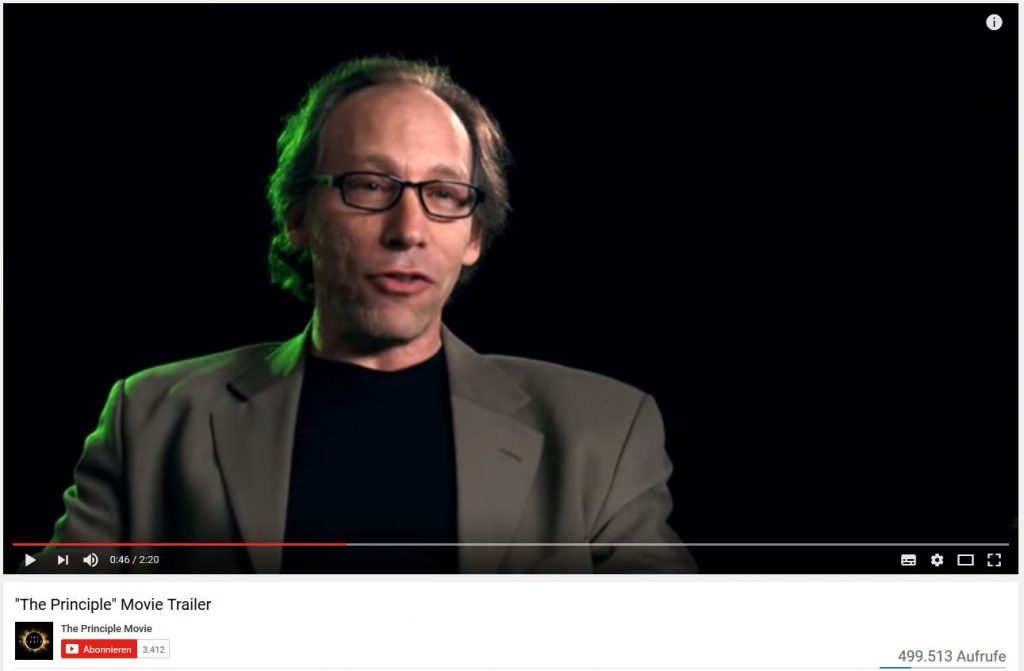The first time around, there was still quite a bit of commotion when two and a half years ago, Kate Mulgrew lent her voice as the narrator to the film The Principle. (A reminder for readers from my generation, that’s The Principle, not The Principal…) That was a bit unusual, considering that Kate Mulgrew can hardly be considered a superstar, even though by now she has once again landed a somewhat prominent role in Orange Is the New Black. However, particularly among us nerds, she will always be remembered as Captain Kathryn Janeway in Star Trek: Voyager.
Obviously, from the commander of a space ship, one would expect a certain understanding of science and particularly of everything related to space. Therefore, it was a rather unpleasant surprise to hear her voice in a „documentary“ claiming that the earth was the center of the universe. Fortunately, Kate Mulgrew had already denounced the film before it appeared, and she made it clear that she had been hired as a speaker without knowing what the film would be about.
As astronomy blogger Phil Plait put it quite well, the film’s main claim (called geocentrism) is even more absurd than creationism, although possibly not quite as wacky as the idea that the earth is flat. Even the flat earth is becoming more and more popular recently, as can easily be seen on Google Trends (in English, the trend is less extreme with a strange spike in January 2016, but the message is the same):
So, it is not just German soul singer Xavier Naidoo who believes in flat earth. There are also other intellectual titans with a tendency to declare themselves citizens of a still existing German Reich and to believe in conspiracy theories. One of them recently gained a certain degree of notoriety by making a fool of himself in a late night call-in show.
These folks fit quite well with the producer of The Principle, because Robert Sungenis has been called „one of the most rabid and open antisemites in the entire radical traditionalist movement“. Besides, Kate Mulgrew isn’t the only one who feels abused by Sungenis‘ product: To support its bizarre claims, the film also uses numerous out-of-context clippings from interviews with popular, reputable physicists like Michio Kaku and, of all people, skeptic and atheist icon Lawrence Krauss.
Not surprisingly, Krauss had a few things to say about that and declared that calling Sungenis‘ ideas „obscene nonsense“ would do a disservice to the word nonsense. Krauss also advocated simply never mentioning the film again, but that is a favor I am not willing to do to him in this context. Michio Kaku hasn’t really said anything on The Principle as far as I know, but that is a problem he must be used to at this point: His popular representations of science are regularly abused in the most absurd ways, sometimes as proof of the existence of god, sometimes as an argument for ingesting colliodal silver, sometimes by followers of the (supposedly) ancient Hawaiian huna cult or by shamans. Other times, one of his books is recommended by a school for spiritual healers. Possibly, Kaku’s pain is even alleviated a bit by the prospect of selling a few books more…
To turn his lunacy about the earth as the center of the universe into relative quantum bollocks (and thus a topic for this blog) Sungenis justifies his claim with – of course – general relativity. According to the theory of relativity, he claims, one could see any given point in the universe as fixed and observe all others based on that. That is actually much older than Einstein’s theory of relativity, as it results from the principle of relativity, which goes all the way back to Galileo: For every observer in uniform motion (not accelerated), physics should be the same. Everyone calculates in one’s own frame of reference, but in the end, everybody should get the same results. According to general relativity, that even applies to observers on the surface of the earch, who are clearly not in uniform motion because the earth rotates around its own axis and moves around the sun (unless you want to believe Mr. Sungenis, of course). From that, Sungenis concludes that it at least allows for his idea of everything moving around the earth – after all, he says, according to general relativity, any point could be the center of the universe, including the earth. However, general relativity does not say you can define any point to be the center. You can only calculate as if it was – in fact, according to general relativity, all points are explicitly equal, meaning there can be no center at all.
One can actually feel bad for Kate Mulgrew, considering the job she inadvertently accepted there. However, one has to say, Kate Mulgrew is not Captain Janeway – in fact, she’s probably a rather uninfluential actress. In the few cases when her opinions on public affairs are actually noticed, that is mostly about Alzheimer’s or about her support for the pro life movement.
That’s a bit different when it comes to her colleague in the Starfleet, Patrick Stewart alias Jean-Luc Picard, captain of the second Enterprise. Not only is Stewart a knight of the British Empire, a former Oxford professor and Prince Andrew’s predecessor as the chancellor of the University of Huddersfield. He is definitely a public person, and his views on life, the universe and everything are taken very seriously by many people. The media reports when he twitters about Donald Trump, publishes a video on the British attitude towards the European convention on human rights, makes statements about conflicts between gay rights and the freedom of expression or if he just says that politicians should watch more Star Trek. By the way, his argument for the latter is precisely the reason why I found the whole Next Generation thing rather boring.
The interesting thing is that apparently nobody cares (or maybe nobody noticed?) that just a few weeks ago, Stewart blundered into the exact same thing Mulgrew did: He sold his voice as the narrator for a pseudo-scientific documentary. The difference to The Principle is that The Connected Universe is explicitly advertised based on Patrick Stewart being the narrator. The director even publically cites Stewart’s „depth of experience behind some of the big questions that he asks in the film.“
The film glorifies the oh-so-groundbreaking insights of questionable physicist Nassim Haramein. I already mentioned Nassim Haramein in a post here in October (in German), stating that he would be worth his own article. So, here it is. The reason for the October post was that Haramein was originally scheduled to appear at a congress on October 22nd in the German college town of Giessen, and he would have been in, uh, let’s say, a unique company: Among the other speakers was Jo Conrad, who once invited to a conference for all the groups who dispute the legitimacy of any German government after Hitler. Also announced was the supreme ruler of the Kingdom of Germany, Peter Fitzek, who wouldn’t have been able to come, anyway, since he’s currently behind bars, trying to explain the whereabouts of 1.3 million Euros of investor money. Then, there should have been Franz Hörmann, a professor at the Vienna University of Economics and Business who was suspended by the university for more than a year because of „questionable statements about the Holocaust“. Hörmann might actually have a solution to Fitzek’s troubles, because he seriously states in a video interview that we have to abolish the use of money or the aliens living among us will put us on another planet. He should have gotten along just fine with yet another previously announced speaker, Britain’s very own Simon Parkes, „life long experiencer of aliens, shadow people, elementals and ufo’s, these include Mantid (Mantis) beings, Draconis Reptilian, Feline, small and tall Grey creatures, Crystalline beings and other creatures that can’t be identified.“ That probably brings us to another speaker, Rick Simpson, who believes that weed cures everything. Unfortunately, the web site with the list of speakers is not archived, but I took a screenshot on August 12, 2016 (after Parkes had already disappeared from the list, probably to hang out with some mantis beings).
The congress organizers were finally kicked out by the Giessen convention center, after we started spreading the news about it, organizing a series of public talks against ideological incitement. Haramein ultimately had to be content appearing at a much smaller event on the same date, the „Fourth Congress for Fringe Science“ in a public gym in Saarbrücken. A week before that, Haramein had an appearance in Sarajevo with nonsense archaeologist Semir Osmanagic, who claims that a Bosnian mountain is actually a man-made stone age pyramid with healing powers.
Of course, the fact that somebody appears together with pseudo scientists, conspiracy theorists, self-proclaimed citizens of the German Reich and alien believers doesn’t necessarily mean that his physics is wrong. Okay, it’s not really a good sign, either… It’s worth taking a closer, critical look at the physics that Haramein and his film are proclaiming.
The key message from the film is once again the old blabber that according to modern physics „everything is connected with everything“. It would actually be much more logical to claim something like that based on classical physics. According to that, one could actually calculate how everything will evolve in the future, if only one had enough information. Because of all the random statistical contributions from quantum mechanics, however, precisely that is impossbile. The typical argument why everything should be connected in quantum physics is entanglement, which I have written about before (again in German, I’m afraid) here and here. Entanglement means that single particles or very small ultra-cold particle systems can form a joint quantum state, as long as they remain completely disconnected from the outside world. Unfortunately, everything has to connect to the outside world in some way to have an effect on us, and that destroys the entanglement. Therefore, entanglement clearly does not say that everything is connected in any meaningful way.
Besides entanglement, Haramein comes up with another reason why everything is connected: According to him, the protons in all atomic nuclei are linked by wormholes, creating a form of universal consciousness he calls spacememory. Wormholes are in fact theoretically imaginable solutions in general relativity, in which two distant points in space and time might be connected by a kind of shortcut in higher dimensions. They are a science fiction favorite, but there is no experimental evidence whatsoever that they might actually exist. There is no evidence to exclude them, either, but at least large wormholes would have to be pretty rare to never have created any observable effects in the visible universe.
Haramein has actually published that idea in a scientific journal – but not in one specializing in physics. The article appeared in Neuroquantology, more of a fringe science journal about possible quantum effects in neuroscience. The journal actually does have peer review, but at least the members of the advisory board (which contains hardly any physicists) are mostly doing rather fringy research themselves, and few of them look like they’re able to follow Haramein’s tractatus about the innards of black holes. If the reviewers of the article were recruited from the same circles, little substantial criticism of Haramein’s physics arguments is to be expected. The editor of the journal is an assistant professor of medicine from Izmir, and according to an analysis of impact in scientific quotations cited in wikipedia, the journal is among the bottom 5 percent of publications in neuroscience.
The key statements of the article itself are pure, unsubstantiated speculation, and it makes a number of non-quantified assumptions that are then called a „model“. What an experimental test of this „model“ could look like is never mentioned. Instead, the article dwells on apparent similarities with other theories that are either themselves highly questionable, like Stuart Hameroff’s ideas on quantum communication of living cells, or utterly devious, like Rupert Sheldrake’s claims about telepathy.
Apparent similarities are generally a key point in the argument made in Haramein’s article. Inbetween, there are two topics (Haramein’s concept of the proton and suspected quantum effects in the skeletal structure of living cells) that are discussed in some depth and scientific detail. During those highly abstract parts, the reader can easily lose track that they provide no reason whatsoever that what has been introduced with the words „it may be that“ before is treated like a proven fact afterwards.
The core of Haramein’s connectedness by wormholes is an idea which he has published before: that protons are actually black holes. That way, he explains the strong nuclear force – which binds the components of nuclei, like protons, as well as the components of their components, the quarks – as an effect of gravity. In a way, that is a charming little idea. Haramein’s problem is that to make that work, a proton would have to be roughly 100,000,000,000,000,000,000,000,000,000,000,000,000 heavier than it actually is. On top of that, his theory is almost entirely based on general relativity while neglecting basic result of quantum mechanics. His attempts to wiggle out of that are a half pathetically unlogical and half trivial but totally unconnected to the problem. That concept has also appeared in a scientific publication: in the conference proceedings of an American Physical Society conference on programming artificial intelligence. How Haramein’s weird proton model fits into the topic of that conference completely beats me, but it gave him a scientific publication in an apparently reputable medium. Haramein’s subsequent „scientific“ publication appeared in an India-based journal that makes the autors pay for the publication. Unfortunately, there are not many competent physicists taking the time to dismantle Haramein’s work in all its detail.
In a way, Haramein is a great expample why scientists need a solid education and why at least physicists usually work in groups and maintain an intense exchange with critical colleagues within their branch of research. Haramein apparently would have the stuff to become a decent theoretical physicist. He knows (and seems to understand) important theories, has original ideas for new models, implements them mathematically and writes articles that conform to the formal criteria. However, between all that he performs bizarre mental leaps, produces circular or disconnected arguments, ignores experimental results (unless they support his ideas), uses obsolete approaches and quotes ideas from the fringes of science. In a „normal“ scientific context, these problems would already come up in the informal exchange with the closest colleagues. At least in critical discussions with other experts on the subject at specialized conferences or in the peer review of the appropriate journals, somebody would find the sore points in his work and help to resolve then.
Haramein’s work is ultimately the result of two generations of maverick science. He appears to never have completed a Ph.D. thesis, and his „full biography“ doesn’t even say if he has any degree at all. Instead, he started publishing his first scientific papers about 15 years ago, working with Elizabeth Rauscher. Rauscher herself had once worked in renowned institutes, but after getting her Ph.D. in 1978, she had mostly run her own Tecnic Research Laboratory and been involved in all kinds of controversial and speculative research there. After that, Haramein started his own Hawaii Institute of Unified Physics, which, according to the publications must have consisted of just him for most of the time. The quantum bollocks resulting from that are most regrettable, because with solid training and the guidance obtainable in a reputable research group, he might actually have become a productive scientist.
The attempt to explain basically all of physics based on an extension of general relativity, down to some details in the approach, the insular style of working and the publications precisely where they will not be understood strongly resemble another hero of the esoterics scene: the German postwar physicist Burkhard Heim. I will take a closer look at Heim’s tragic life and his questionable scientific heritage in my talk at the next SkepKon from April 29th to May 1st 2016 in Berlin.
Of course, one can hardly expect an actor to do all that research before taking on a narrator role in a documentary for probably mediocre pay. On the other hand, one would have expected the man who was Captain Picard to at least take a five minute look at what’s readily available in Google. A former university chancellor might have actually invested ten minutes.
What’s left as a consolation to me is that I always preferred the first Enterprise crew, anyway. Leonard Nimoy (Commander Spock) may have been a little too religious for my taste, but at least he was religious in a progressive and sometimes provocative way. Nichelle Nichols (Lt. Uhura) spent many years getting women and people from minorities to work in space exploration, and after a stroke, she’s back before a camera at age 83. George Takei (Lt. Sulu), who is not much younger, is still a strong voice for science and reason in the social networks. And William Shatner (Captain Kirk)… well, he’s William Shatner!









